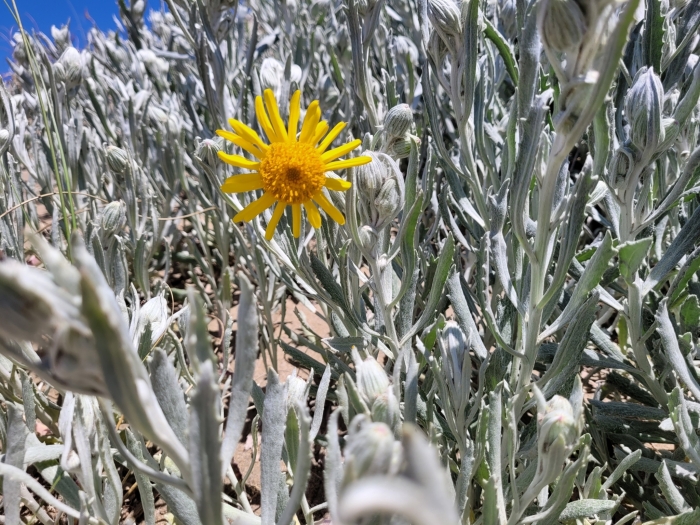Margarida-Das-Dunas
(Senecio crassiflorus)
Margarida-Das-Dunas (Senecio crassiflorus)
/
/

© Romi Galeota Lencina
CC BY 4.0
Image By:
© Romi Galeota Lencina
Recorded By:
Copyright:
CC BY 4.0
Copyright Notice:
Photo by: © Romi Galeota Lencina | License Type: CC BY 4.0 | License URL: http://creativecommons.org/licenses/by/4.0/ | Uploader: romigaleota | Publisher: iNaturalist |























Estimated Native Range
Summary
Senecio crassiflorus, commonly known as margarida-das-dunas, is a perennial herb native to coastal sand dunes and beachfront areas of South America, particularly in Brazil. It typically grows up to 20 inches tall and is characterized by its silvery to white woolly foliage, which helps to reflect sunlight and conserve water. The plant produces yellow composite flowers that bloom in the warmer months, adding a splash of color to its native sandy habitats. Margarida-das-dunas plays a crucial role in stabilizing dunes, preventing erosion, and providing habitat for local wildlife.
In cultivation, Senecio crassiflorus is valued for its drought tolerance and unique silvery foliage, which can add textural contrast to garden beds and borders. It is often used in xeriscaping, coastal gardens, and as a ground cover in areas with poor, sandy soil. This species prefers full sun and well-drained soils, and once established, it requires minimal water, making it an excellent choice for low-maintenance landscapes. While it is not commonly afflicted by diseases, it can be sensitive to overwatering, which may lead to root rot. Gardeners should be cautious of its potential to spread in favorable conditions, as it can become invasive outside of its native range.CC BY-SA 4.0
In cultivation, Senecio crassiflorus is valued for its drought tolerance and unique silvery foliage, which can add textural contrast to garden beds and borders. It is often used in xeriscaping, coastal gardens, and as a ground cover in areas with poor, sandy soil. This species prefers full sun and well-drained soils, and once established, it requires minimal water, making it an excellent choice for low-maintenance landscapes. While it is not commonly afflicted by diseases, it can be sensitive to overwatering, which may lead to root rot. Gardeners should be cautious of its potential to spread in favorable conditions, as it can become invasive outside of its native range.CC BY-SA 4.0
Plant Description
- Plant Type: Herb
- Height: 1-3 feet
- Width: 1-2 feet
- Growth Rate: Moderate
- Flower Color: Yellow
- Flowering Season: Summer
- Leaf Retention: Deciduous
Growth Requirements
- Sun: Full Sun, Part Shade
- Water: Low
- Drainage: Medium, Fast
Common Uses
Border Plant, Drought Tolerant, Low Maintenance, Rock Garden
Natural Habitat
Coastal sand dunes and beachfront areas
Other Names
Common Names: Broad-Leaved Ragwort
Scientific Names: , Senecio crassiflorus, Cineraria crassiflora, Cineraria vestita, Senecio andryaloides, Senecio crassiflorus f. crassiflorus, Senecio crassiflorus var. andryaloides, Senecio crassiflorus var. grandiflorus, Senecio crassiflorus var. parviflorus, Senecio crassiflorus var. tricuspis
GBIF Accepted Name: